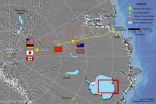Trouble with the latest dance move? GABA might be to blame
2011-03-04
(Press-News.org) If you tend to have trouble picking up the latest dance moves or learning to play a new piano piece, there might be an explanation. A new study published online on March 3rd in Current Biology, a Cell Press publication, shows that people who are fast to learn a simple sequence of finger motions are also those whose brains show large changes in a particular chemical messenger following electrical stimulation.
That chemical messenger, known as GABA, is important for the plasticity of the motor cortex, a brain region involved in planning, control, and execution of voluntary movements.
"There is considerable variability in motor learning behavior across individuals," said Charlotte Stagg of the University of Oxford. "We aimed to test whether some of this variability could be explained by variation in responsiveness of the GABA system."
The researchers used magnetic resonance spectroscopy to directly measure GABA levels in the brain both before and after a low-level current was delivered through research participants' scalps. That procedure, called anodal transcranial direct current stimulation (tDCS), is known to produce a decrease in GABA within the motor cortex. The exercise therefore allowed the researchers to quantify individuals' baseline GABA levels and their "GABA responsiveness."
On a separate day, those individuals were asked to learn a sequence of finger motions while their brains were again scanned by functional magnetic resonance imaging (fMRI). It turned out that those who were more GABA responsive were also quicker to learn the simple motor task. The brains of more GABA-responsive individuals also showed greater activation in the motor cortex during learning. The researchers also found that those with higher GABA concentrations at baseline tended to have slower reaction times and less brain activation during learning.
The findings suggest that GABA responsiveness may be key in the motor cortex for making the neural connections that are the cellular basis for learning and memory, the researchers say. They also offer an important window into recovery after brain injury, such as a stroke.
GABA levels can change after that kind of brain trauma, and the findings support the idea that treatments designed to influence GABA levels might improve learning. In fact, tDCS is already in use as a tool for motor rehabilitation in stroke patients.
"This shows how that might work," Stagg said. It may also lead to strategies for making those improvements longer lasting, she added.
INFORMATION: END
ELSE PRESS RELEASES FROM THIS DATE:
2011-03-04
A new study finds that a brain rhythm considered the hallmark of wakefulness not only persists inconspicuously during sleep but also signifies an individual's vulnerability to disturbance by the outside world. In their report in the March 3 PLoS One, the team from the Massachusetts General Hospital (MGH) Division of Sleep Medicine uses computerized EEG signal processing to detect subtle fluctuations in the alpha rhythm during sleep and shows that greater alpha intensity is associated with increased sleep fragility. The findings could lead to more precise approaches to ...
2011-03-04
There have been no shortages of horrific natural disasters splashing across headlines in the last year: the devastating earthquakes in Haiti and Chile; the Tsunami in the Philippines; and the volcano eruption in Indonesia--to name just a few. The poly tarps have come to the rescue over and over again in these situations, providing a cheap yet durable material with which to construct a roof or otherwise assist in the process of recovering and rebuilding from natural disaster born tragedy.
In the event of a natural disaster, as people are forced out of their homes or lose ...
2011-03-04
How do organs "know" when to stop growing? The answer could be useful in regenerative medicine, and also in cancer – where these "stop growing" signals either aren't issued or aren't heeded. Researchers in the Stem Cell Program at Children's Hospital Boston have now found a regulator of gene activity that tells epidermal stem cells when it's time to grow more skin, as well as a "crowd control" molecule that can sense cell crowding and turn the growth off.
The work, in mice and in human cancer cells, provides clues to new therapeutic strategies for cancer, particularly ...
2011-03-04
Not all racial and ethnic groups have equal access to kidney transplantation, according to a study appearing in an upcoming issue of the Journal of the American Society Nephrology (JASN). The results indicate that the reasons for these disparities are varied and that more focused efforts are needed to address them.
For most individuals who develop kidney failure or end-stage renal disease, kidney transplantation is the best treatment option. Unfortunately, certain racial and ethnic groups are less likely to receive kidney transplants than others. Despite the increasing ...
2011-03-04
STANFORD, Calif. — Neurons have been derived from the skin of a woman with a genetic form of Parkinson's disease and have been shown to replicate some key features of the condition in a dish, say researchers at the Stanford University School of Medicine. The scientists hope to use the neurons to learn more about the disorder and to test possible treatments. Such a tool is critical because there are no good animal models for Parkinson's disease. It also validates the use of induced pluripotent stem cells, or iPS cells, to model various diseases.
"Now that we can see that ...
2011-03-04
STANFORD, Calif. — A short-term treatment with three immune-dampening drugs allowed human embryonic stem cells to survive and thrive in mice, according to researchers at the Stanford University School of Medicine. Without such treatment, the animals' immune systems quickly hunt down and destroy the transplanted cells. The finding is important because it may allow humans to accept transplanted stem cells intended to treat disease or injury without requiring the ongoing use of powerful immunosuppressant medications.
Just as it does with transplanted organs, the human body ...
2011-03-04
Plants are able to protect themselves from most bacteria, but some bacteria are able to breach their defences. In research to be published in Science on Friday, scientists have identified the genes used by some strains of the bacterium Pseudomonas to overwhelm defensive natural products produced by plants of the mustard family, or crucifers.
"Microbes only become pathogens when they find a way to infect a host and overwhelm the host defences," said lead author Dr Jun Fan from the John Innes Centre on the Norwich Research Park.
"Our findings answer some important questions ...
2011-03-04
PULLMAN, Wash.—Scientific societies representing 40,000 researchers and clinicians are asking that federal regulators tap a broader range of expertise when evaluating the risks of chemicals to which Americans are being increasingly exposed.
Writing in a letter in the journal Science, eight societies from the fields of genetics, reproductive medicine, endocrinology, developmental biology and others note that some 12,000 new substances are being registered with the American Chemical Society daily. Few make it into the environment, but the top federal regulators, the U.S. ...
2011-03-04
Scientists working in the remotest part of Antarctica have discovered that liquid water locked deep under the continent's coat of ice regularly thaws and refreezes to the bottom, creating as much as half the thickness of the ice in places, and actively modifying its structure. The finding, which turns common perceptions of glacial formation upside down, could reshape scientists' understanding of how the ice sheet expands and moves, and how it might react to warming climate, they say. The study appears in this week's early online edition of the leading journal Science; ...
2011-03-04
Irvine, Calif. — A UC Irvine research team led by Todd C. Holmes has discovered a second form of phototransduction light sensing in cells that is derived from vitamin B2. This discovery may reveal new information about cellular processes controlled by light.
For more than 100 years, it had been believed that the phototransduction process was solely based on a chemical derived from vitamin A called retinal. Phototransduction is the conversion of light signals into electrical signals in photoreceptive neurons and underlies both image-forming and non-image-forming light ...
LAST 30 PRESS RELEASES:
[Press-News.org] Trouble with the latest dance move? GABA might be to blame



